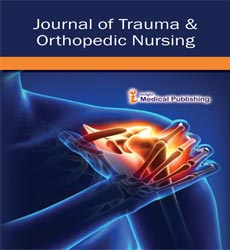Rehabilitation Nursing Interventions for Polytrauma Patients: Improving Mobility and Quality of Life
Laura Schneider*
Department of Trauma Surgery and Nursing, Charité – Universitätsmedizin Berlin, Berlin, Germany
Received date: January 02, 2025, Manuscript No. ipton-25-20823; Editor assigned date: January 04, 2025, PreQC No. ipton-25-20823 (PQ); Reviewed date: January 15, 2025, QC No. ipton-25-20823; Revised date: January 20, 2025, Manuscript No. ipton-25-20823 (R); Published date: January 27, 2025, DOI: 10.36648/ipton.8.1.114
Citation: Schneider L (2025) Rehabilitation Nursing Interventions for Polytrauma Patients: Improving Mobility and Quality of Life. J Trauma Orth Nurs Vol.8 No.1: 114.
Introduction
Polytrauma, defined as multiple injuries affecting different organ systems, is a critical condition that often results in long-term disability, functional impairment, and psychosocial challenges. Survivors face an arduous journey that extends beyond acute surgical stabilization and critical care. Rehabilitation nursing interventions are vital in this continuum, as they address physical, psychological, and social dimensions of recovery. By promoting mobility and enhancing quality of life, rehabilitation nurses help polytrauma patients regain independence and reintegrate into their communities. Rehabilitation nurses act as both caregivers and educators, guiding patients through the complex process of recovery. They provide direct clinical care, coordinate with multidisciplinary teams, and support patients and families in adapting to new health realities. Their holistic approach ensures that physical, emotional, and functional needs are addressed simultaneously, maximizing rehabilitation outcomes [1].
Description
One of the key nursing interventions in polytrauma rehabilitation is early mobilization. Prolonged bed rest increases the risk of complications such as pressure ulcers, muscle atrophy, and thromboembolism. Rehabilitation nurses initiate safe mobilization, beginning with passive and active range-of-motion exercises, progressing to assisted ambulation. This stepwise approach preserves joint integrity, strengthens muscles, and fosters confidence in patients. Effective pain control is essential to enable participation in physical therapy and daily activities. Nurses employ multimodal pain management strategies, including medications, positioning, relaxation techniques, and non-pharmacological interventions. Regular pain assessments and tailored approaches ensure that pain is controlled without compromising patient safety, thereby supporting active engagement in rehabilitation programs. Regaining independence in daily activities is a major goal for polytrauma patients. Rehabilitation nurses train patients in self-care activities such as grooming, eating, and dressing, often with the aid of adaptive equipment [2].
By breaking tasks into manageable steps and encouraging incremental progress, nurses empower patients to rebuild autonomy and reduce dependence on caregivers. Polytrauma often has profound psychological consequences, including depression, anxiety, and post-traumatic stress. Rehabilitation nurses provide therapeutic communication, coping strategies, and psychosocial support to patients and families. They also collaborate with psychologists and social workers to address deeper emotional needs, ensuring that recovery is not limited to physical outcomes but encompasses mental well-being as well [3].
Healing and rehabilitation require adequate nutrition. Rehabilitation nurses collaborate with dietitians to ensure that patients receive diets rich in protein, vitamins, and minerals essential for tissue repair and energy. Monitoring hydration and caloric intake prevents malnutrition, while tailored nutritional support promotes faster recovery and strengthens overall functional capacity. Polytrauma patients are at high risk for complications such as contractures, infections, deep vein thrombosis, and respiratory problems. Rehabilitation nurses implement preventive measures, including frequent repositioning, use of compression devices, respiratory exercises, and vigilant wound care. Early detection and prompt intervention significantly reduce morbidity and improve long-term outcomes [4].
The involvement of families is crucial in polytrauma rehabilitation. Nurses educate caregivers about patient needs, safe transfer techniques, and the use of assistive devices. They also provide guidance on managing emotional stress within families, strengthening the support network around the patient. This partnership promotes continuity of care and smoother adaptation at home disciplines. Successful rehabilitation of polytrauma patients requires seamless teamwork among healthcare professionals. Rehabilitation nurses serve as the link between physicians, physiotherapists, occupational therapists, psychologists, and social workers. By coordinating care and ensuring effective communication, they help create individualized recovery plans that address diverse patient needs [5].
Conclusion
Rehabilitation nursing interventions are indispensable in the recovery journey of polytrauma patients, bridging the gap between survival and meaningful living. By focusing on mobility, independence, emotional support, and complication prevention, rehabilitation nurses optimize functional outcomes and improve quality of life. Their role within interdisciplinary teams ensures holistic care that empowers patients and families alike. As the prevalence of polytrauma continues to rise, rehabilitation nurses will remain central to advancing recovery pathways that foster resilience, dignity, and reintegration into society.
Acknowledgement
None.
Conflict of Interest
None.
References
- Aiken LH, Sloane DM, Bruyneel L, Van den Heede K, Griffiths P, et al. (2014). Nurse staffing and education and hospital mortality in nine European countries: A retrospective observational study. Lancet383: 1824-1830.
Google Scholar Cross Ref Indexed at
- Ferguson EF, Jimenez-Muñoz M, Feerst H, Vernon TW. (2022). Predictors of satisfaction with autism treatment services during COVID-19. J Autism Dev. Disord52: 3686-3697.
Google Scholar Cross Ref Indexed at
- Rosenthal VD, Ramachandran B, Duenas L, Alvarez-Moreno C, Navoa-Ng JA, et al. (2012). Findings of the International Nosocomial Infection Control Consortium (INICC: Part I: Effectiveness of a multidimensional infection control approach on catheter-associated urinary tract infection rates in pediatric intensive care units of 6 developing countries. Infect Control Hosp Epidemiol33: 696-703.
Google Scholar Cross Ref Indexed at
- Mouajou V, Adams K, DeLisle G, Quach, C. (2022). Hand hygiene compliance in the prevention of hospital-acquired infections: A systematic review. J Hosp Infect119: 33-48.
Google Scholar Cross Ref Indexed at
- Borgert MJ, Goossens A, Dongelmans DA. (2015). What are effective strategies for the implementation of care bundles on ICUs: A systematic review. Implement Sci10: 119.
Open Access Journals
- Aquaculture & Veterinary Science
- Chemistry & Chemical Sciences
- Clinical Sciences
- Engineering
- General Science
- Genetics & Molecular Biology
- Health Care & Nursing
- Immunology & Microbiology
- Materials Science
- Mathematics & Physics
- Medical Sciences
- Neurology & Psychiatry
- Oncology & Cancer Science
- Pharmaceutical Sciences
